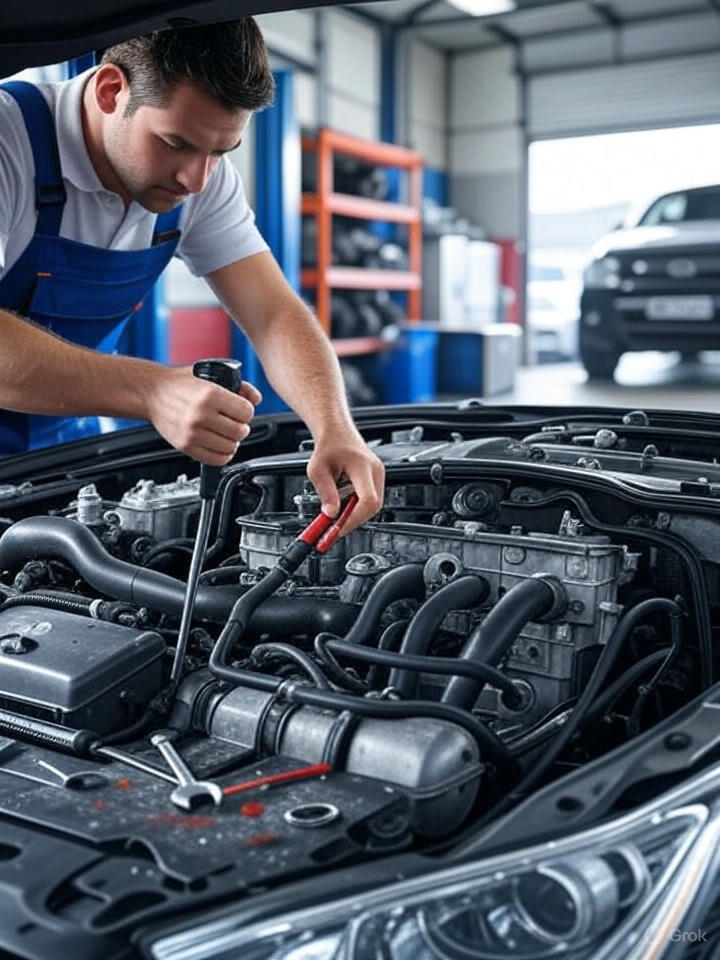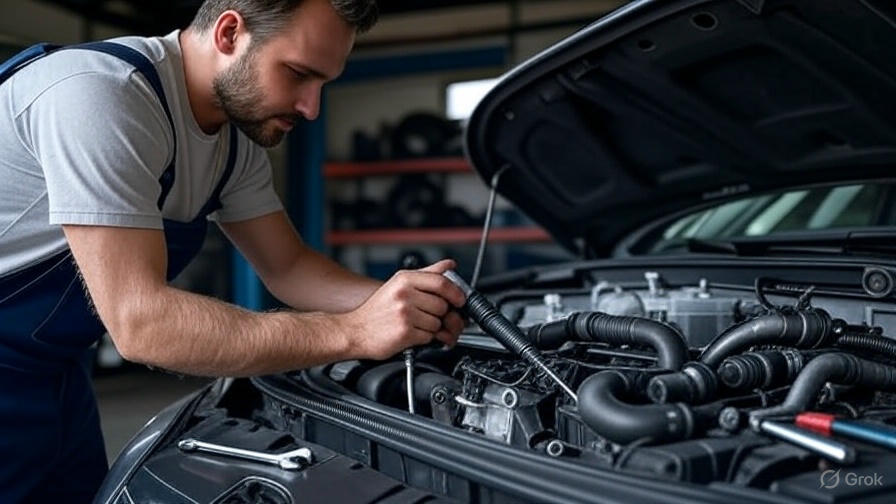A coolant leak in your vehicle can be a sneaky problem that starts small but can lead to significant engine damage if ignored. For car owners and DIY enthusiasts who frequent tools-related blogs, understanding the costs associated with fixing a coolant leak—and the tools required to tackle it—is crucial. Whether you’re a seasoned mechanic or a weekend warrior wielding a wrench, this guide will break down the factors affecting coolant leak repair costs, typical price ranges, and practical steps to diagnose and fix the issue yourself or with a professional.
What Is a Coolant Leak and Why Does It Matter?
Coolant, often referred to as antifreeze, is a vital fluid that regulates your vehicle’s engine temperature, preventing overheating in hot conditions and freezing in cold ones. It circulates through components like the radiator, hoses, water pump, and thermostat, absorbing and dissipating heat to keep the engine running smoothly. A coolant leak occurs when this system is compromised, allowing fluid to escape.
Ignoring a coolant leak can lead to severe consequences, such as engine overheating, warped cylinder heads, or even a blown head gasket, which can cost thousands to repair. Early detection and repair are essential to avoid these pricey outcomes. But how much does it cost to fix a coolant leak, and what tools can help you address it? Let’s dive in.
Factors Affecting Coolant Leak Repair Costs
The cost of fixing a coolant leak varies widely depending on several factors. Understanding these can help you budget effectively and decide whether to tackle the repair yourself or hire a professional.
1. Source of the Leak
The location of the leak significantly impacts repair costs. Common sources include:
- Radiator: Cracks or corrosion in the radiator can cause leaks. Repairs might involve patching small holes or replacing the entire radiator.
- Hoses: Worn or loose hoses are a frequent culprit. Replacing a hose is typically inexpensive, but labor can add up.
- Water Pump: A failing water pump may leak coolant, requiring replacement of seals or the entire unit.
- Thermostat Housing: Cracks in the thermostat housing can lead to leaks, often requiring a new gasket or housing.
- Head Gasket: A blown head gasket is one of the most expensive coolant leak issues, as it involves significant labor to access and replace.
2. Vehicle Make and Model
Luxury or high-performance vehicles often have complex cooling systems and pricier parts, increasing repair costs. For example, a radiator for a BMW may cost more than one for a Honda Civic. Older vehicles might have cheaper parts but could require more frequent repairs due to wear and tear.
3. Severity of the Leak
Minor leaks, such as a loose hose clamp or a small crack in a hose, are generally inexpensive to fix. Severe leaks, like those caused by a cracked engine block or head gasket, can be significantly costlier due to the complexity of the repair and the need for specialized tools.
4. Labor Costs
Labor charges vary by region and repair shop. Urban areas or dealerships typically charge higher hourly rates ($75–$150 per hour) than independent shops. DIY repairs can save on labor but require the right tools and expertise.
5. Diagnostic Fees
Diagnosing a coolant leak often involves a pressure test or UV dye to pinpoint the source. Professional diagnostic fees typically range from $60 to $100, though some shops include this in the repair cost.
6. Additional Damage
If the leak has caused engine overheating or other damage, repair costs can escalate. For instance, a warped cylinder head or damaged valves may require extensive engine work, pushing costs into the thousands.

Average Cost to Fix a Coolant Leak
Based on industry data and typical repair scenarios, here’s a breakdown of coolant leak repair costs in the U.S. as of 2025:
- Minor Repairs (e.g., hose clamp tightening, small hose replacement, radiator cap replacement): $50–$150. These fixes are often quick and may only require basic tools like a screwdriver or pliers.
- Radiator Repair or Replacement: $100–$900. Patching a radiator might cost $100–$400, while a full replacement, including labor, can range from $300 to $900.
- Water Pump Replacement: $300–$1,000. This involves removing belts and other components, requiring tools like a socket set and torque wrench.
- Thermostat or Housing Replacement: $200–$500. This repair often involves replacing gaskets and may require a ratchet set and gasket scraper.
- Head Gasket Replacement: $1,000–$2,500+. This is a labor-intensive repair, often requiring specialized tools like an engine hoist or head bolt torque tool.
- Engine Block or Cylinder Head Repair: $1,500–$10,000. Severe damage may necessitate a full engine rebuild or replacement, a job best left to professionals with advanced equipment.
On average, most drivers can expect to pay around $275 for a coolant leak repair, with costs ranging from $150 to $400 for common issues like radiator or hose leaks. However, severe cases can exceed $1,000, particularly for luxury vehicles or complex repairs.
DIY vs. Professional Repair: Which Is Right for You?
For readers of a tools-related blog, the prospect of fixing a coolant leak yourself may be appealing. Let’s explore the pros and cons of DIY versus professional repair, along with the tools you’ll need.
DIY Coolant Leak Repair
Pros:
- Cost Savings: You’ll only pay for parts and coolant, potentially saving hundreds on labor.
- Learning Experience: Fixing a coolant leak can be a rewarding project, especially if you enjoy working with tools.
- Control: You decide the quality of parts and ensure the job is done to your standards.
Cons:
- Skill Level: Diagnosing and fixing a coolant leak requires mechanical knowledge. Misdiagnosis can lead to further damage.
- Time: Repairs can take hours, especially for complex issues like a water pump or thermostat replacement.
- Safety Risks: Handling coolant and working on a hot engine can be hazardous without proper precautions.
Tools Needed for DIY Repair:
- Basic Hand Tools: Screwdrivers, pliers, and a ratchet set with various sockets for removing clamps, hoses, or components.
- Cooling System Pressure Tester: Essential for pinpointing leaks ($50–$150).
- UV Dye Kit: Helps locate hard-to-find leaks when used with a UV flashlight ($20–$50).
- Torque Wrench: Ensures bolts are tightened to manufacturer specifications, critical for components like the thermostat or water pump ($30–$100).
- Gasket Scraper: Useful for cleaning old gasket material ($10–$20).
- Drain Pan: Catches spilled coolant during repairs ($10–$30).
- Shop Towels and Gloves: For safe handling of coolant, which can be toxic.
Steps for DIY Repair:
- Locate the Leak: Check for puddles under the vehicle, inspect hoses, the radiator, and the water pump for visible leaks, or use a pressure tester with UV dye.
- Drain the Coolant: Place a drain pan under the radiator and open the drain plug to empty the system.
- Replace Faulty Parts: For example, replace a cracked hose or tighten a loose clamp using appropriate tools.
- Refill and Test: Refill the system with the manufacturer-recommended coolant, then run the engine to check for leaks.
- Monitor: Check coolant levels after a test drive and over the next few days to ensure the repair holds.
Professional Repair
Pros:
- Expertise: Mechanics have specialized tools and experience to diagnose and fix leaks accurately.
- Warranty: Many shops offer warranties on parts and labor, providing peace of mind.
- Time-Saving: Professionals can complete repairs faster than most DIYers.
Cons:
- Higher Costs: Labor and shop markups increase the total bill.
- Less Control: You rely on the mechanic’s judgment and parts selection.
If you lack the tools, time, or confidence to tackle a coolant leak, a professional mechanic is the safer choice, especially for complex repairs like head gasket replacement.
Signs of a Coolant Leak
Recognizing a coolant leak early can save you from costly repairs. Watch for these symptoms:
- Puddles Under the Vehicle: Look for green, yellow, or orange fluid under your car, often with a sweet smell.
- Low Coolant Levels: Check the coolant reservoir regularly; frequent top-offs indicate a leak.
- Overheating Engine: A rising temperature gauge or warning light suggests insufficient coolant.
- Sweet Odor: Coolant has a distinct, syrupy smell when it leaks onto a hot engine.
- White Smoke from Exhaust: This may indicate an internal leak, such as a blown head gasket.
- Dashboard Warning Lights: Many vehicles have a low coolant or overheating warning light.
Preventing Coolant Leaks
Prevention is always better than repair. Here are tips to keep your cooling system in top shape:
- Regular Maintenance: Follow your vehicle’s maintenance schedule for coolant flushes (every 30,000–100,000 miles, depending on the coolant type).
- Inspect Components: Check hoses, clamps, and the radiator for wear during routine maintenance.
- Use Quality Coolant: Always use the manufacturer-recommended coolant to prevent corrosion.
- Avoid Overloading: Heavy loads can stress the cooling system, leading to leaks.
- Invest in Quality Tools: A pressure tester and basic hand tools can help you catch issues early.
Tools Spotlight: Must-Haves for Cooling System Maintenance
For readers of your tools-related blog, investing in the right tools can make coolant leak repairs more manageable. Here are some recommendations:
- Stant Cooling System Pressure Tester: A reliable tool for diagnosing leaks, compatible with most vehicles.
- Craftsman Ratchet Wrench Set: Versatile for removing bolts on hoses, thermostats, or water pumps.
- Lisle Gasket Scraper: Perfect for cleaning old gasket material without damaging surfaces.
- GearWrench Torque Wrench: Ensures precise tightening, critical for preventing future leaks.
- UV Leak Detection Kit: Affordable and effective for pinpointing elusive leaks.
Conclusion: Budgeting for Coolant Leak Repairs
Fixing a coolant leak can cost anywhere from $50 for a simple DIY fix to over $2,500 for a head gasket replacement at a shop. The average repair falls around $275, but costs depend on the leak’s source, vehicle type, and whether you choose DIY or professional repair. For tool enthusiasts, tackling minor leaks with the right equipment can be a cost-effective and rewarding project. However, complex issues like head gasket or engine block repairs are best left to professionals with specialized tools.
By staying vigilant for signs of a coolant leak and maintaining your vehicle’s cooling system, you can avoid costly damage and keep your car running smoothly. Whether you’re tightening a hose clamp with a screwdriver or investing in a pressure tester for diagnostics, the right tools and knowledge are your best allies in managing coolant leak repairs.

